IASbaba's Daily Current Affairs Analysis
Archives
(PRELIMS & MAINS Focus)
Syllabus
- Prelims – History and Art and Culture
Context: Recently in a significant development in the Tibetan Buddhist circles, the Nyingma sect has identified a boy from Spiti in Himachal Pradesh as the “reincarnation” of the late Taklung Setrung Rinpoche, a scholar known for his knowledge of Tibetan Tantric school.
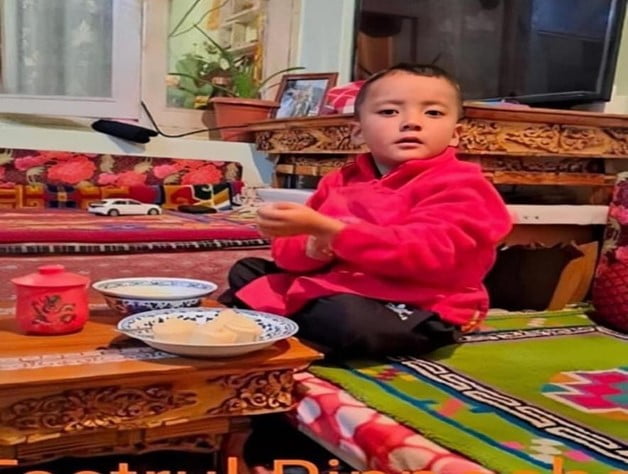
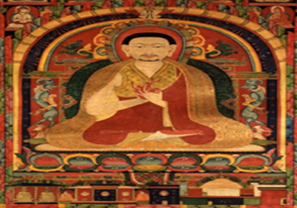
About Nyingma Sect:
- The Nyingmapa order has the longest history establishment history of transmitting all the four major traditions of Tibetan Buddhism.
- This is reflected in the name Nyingma, which literary means “Old Order”.
- The Other three main Tibetan Buddhism schools, Sakya, Kagyu, and Gelug, collectively refer to New Order (Sarma).
- They rely on the translation of Buddhist script from India during the second dissemination of Buddhism to Tibet.
- Nyingmapa’s trace their translation lineage back to the Samye Monastery, the first Tibetan Buddhist monastery in Tibet.
- During the time, hundreds of scholars and translators translated Sutras and Tantras to the Tibetan Language.
- The Same Monastery where the first seven locals are ordained as monk marks the bugging of Monkshood in Tibet.
- The Rinpoche used to live in the Takthok monastery of Ladakh, one of the oldest monasteries related to the sect.
- Its followers are spread across Tibet, Bhutan, Ladakh, Sikkim and other Himalayan pockets.
- Nyingma in Tibetan means “ancient” and has roots going back to the 8th century.
- The Nyingma sect is also known as the Red Hat sect because its Lamas wear red robes and hats.
Some Unique Aspects Nyingmapa Tradition:
- The practice of Dzogchen (Great Perfection). It the highest perfection in deity visualization.
- It seeks to directly examine the fundamental mind without the aid of Visualization like statue and Thangkha.
- The tradition of Terma. Padmasambhava has hidden lots of scriptures in a different location for the future master to find and preach.
Teachings of the Nyingma Sect:
- Its teachings are mainly based on those of Padmasambhava, called Guru Rinpoche and Shantarakshita who were brought to Tibet through the rule of the Emperor Trisong Detsen from 742 to 797 CE.
- Buddhist teachings are classified into nine yanas with ‘Dzogchen’ being most important.
- Dzogchen (Great Perfection) philosophy revolves around pure awareness which can be achieved through meditation.
- This Vajrayana tradition involves use of ritual, symbols and tantric practices to achieve nirvana.
- Therefore, Nyingma stresses on teachings attributed to Padmasambhava, the Dzogchen doctrines as well as Tantric practices.
- The Nyingma School is also associated with Termas (hidden treasures).
Some major Monasteries of Nyingmapa Sect in Tibet
- There is the monastery of Nyingmapa in every corner of Tibet.
- The most important monastery in Tibet is Mindrolling monastery near Lhasa airport, Dorjee dark monastery, Rongbuk Monastery at Everest Basecamp and Samye Monastery.
Source: The Hindu
Previous Year Questions
Q.1) With reference to Indian history, consider the following pairs:
Historical person Known as
- Aryadeva Jaina scholar
- Dignaga Buddhist scholar
- Nathamuni Vaishnava scholar
How many pairs given above are correctly matched ? (2022)
- None of the pairs
- Only one pair
- Only two pairs
- All three pairs
Q.2) With reference to Indian history, who among the following is a future Buddha, yet to come to save the world? (2018)
- Avalokiteshvara
- Lokesvara
- Maitreya
- Padmapani
Syllabus
- Prelims – Environment and Ecology
Context: During recently concluded the 19th Conference of Parties (COP19) to the Convention on International Trade in Endangered Species of Wild Fauna and Flora (CITES) urged countries, to remove references to parts and derivatives of pangolins “from the official pharmacopoeia” to help save the species.
About Pangolins:

- Scientific Name: Manis crassicaudata
- The Indian pangolin is the largest among eight pangolin species.
- Of the eight species of pangolin worldwide, two are found in India. They are Chinese pangolin (manis pentadactyla), mostly found in northeast India and Indian pangolin (Manis crassicaudata).
Animal Description:
- It has large, overlapping scales on its body that act as armour.
- It can also curl itself into a ball (volvation) as self-defence against predators such as the tiger.
- The nocturnal animal lives in burrows and feed on ants and termites.
Habitat and Distribution:
- The species is understood to occur in various types of tropical forests as well as open land, grasslands and degraded habitats, including close to villages.
- The species can adapt well to modified habitats, provided its ant and termite prey remains abundant
- It is widely distributed in India, except in the arid region, high Himalayas and the North-East.
- It can be found at elevations up to 2500 m. The species also occurs in Bangladesh, Pakistan, Nepal and Sri Lanka.
- Threats: Poaching for its meat and scales, which are used and consumed by local people, but are also increasingly traded internationally.
- The scales serves as base component for indigenous (traditional) psychotropic substances.
- China is main illicit hub (market) for smuggled scales of Pangolins, where they have huge demand for medicinal and magical purposes.
- Protection status : Indian Pangolins
- Schedule I under Wildlife (Protection) Act, 1972.
- Appendix I of the International Convention of Trade in Endangered Species (CITES).
- Endangered in IUCN Red List.
- Chinese pangolin has been listed as “critically endangered” by UN affiliated International Union for Conservation of Nature’s (IUCN) Red List.
About CITES:
- CITES (the Convention on International Trade in Endangered Species of Wild Fauna and Flora, also known as the Washington Convention) is a multilateral treaty to protect endangered plants and animals from the threats of international trade.
- It was drafted as a result of a resolution adopted in 1963 at a meeting of members of the International Union for Conservation of Nature (IUCN).
- AIM: Its aim is to ensure that international trade (import/export) in specimens of animals and plants included under CITES, does not threaten the survival of the species in the wild.
- Although CITES is legally binding on the Parties it does not take the place of national laws.
- Rather it provides a framework to be respected by each Party, which has to adopt its own domestic legislation to ensure that CITES is implemented at the national level.
Source: DownToEarth
Previous Year Questions
Q.1) With reference to India’s biodiversity, Ceylon Frogmouth, Coppersmith Barbet, Gray Chinned Minivet and White-throated Redstart are (2021)
- Birds
- Primates
- Reptiles
- Amphibians
Q.2) With reference to the International Union for Conservation of Nature and Natural Resources (IUCN) and the Convention on International Trade in Endangered Species of Wild Fauna and Flora (CITES), which of the following statements is/are correct? (2015)
- IUCN is an organ of the United Nations and CITES is an international agreement between governments
- IUCN runs thousands of field projects around the world to better manage natural environments
- CITES is legally binding on the States that have joined it, but this Convention does not take the place of national laws
Select the correct answer using the code given below.
- 1 only
- 2 and 3 only
- 1 and 3 only
- 1, 2 and 3
Syllabus
- Prelims – Science and Technology
In news: India carried out a successful training launch of the Intermediate Range Ballistic Missile (IRBM) Agni-3 developed by DRDO, from APJ Abdul Kalam Island, Odisha, as part of routine user training launches conducted by the Strategic Forces Command.
About Agni-3 missile:
- Two-stage solid propellent powered, nuclear capable, Intermediate range ballistic missile (IRBM)
- It is 16-meter-long, weighing more than 48 tonnes, has a range of over 3000 kilometres and can carry a payload of over 1.5 tonnes.
- It was subsequently successfully flight tested in 2007.
- It is under operational purview of the Strategic Forces Command, which is part of India’s Nuclear Command Authority.
- The Agni-3 test comes over a month after India’s Strategic Strike Nuclear Submarine, INS Arihant, carried out a successful launch of a Submarine Launched Ballistic Missile (SLBM).
- The strategic postures of “credible minimum deterrence” and “no first use” are pivotal to India’s nuclear doctrine.


Source: Indian Express
Previous Year Question
Q.1) With reference to Agni-IV Missile, which of the following statement(s) is/are correct? (2014)
- It is surface-to-surface missile.
- It is fuelled by liquid propellant only.
- It can deliver one tonne nuclear warhead about 7500 km away.
Select the correct answer using the codes given below.
- 1 only
- 2 and 3 only
- 1 and 3 only
- 1, 2 and 3
Syllabus
- Prelims – Current Affairs
In news: Indian wildlife biologist Dr Purnima Devi Barman has been honoured with the U.N. Environment Programme’s (UNEP) 2022 Champions of the Earth award in the Entrepreneurial Vision category.
About the award:
- Established in 2005, it is U.N.’s highest environmental honour.
- It is an annual award accorded for transformative action to prevent, halt and reverse ecosystem degradation.
- In 2017, the program was expanded to include Young Champions of the Earth.
- The initiative is run in partnership with the Covestro, a plastics company.
- awarded every year to seven young environmentalists between ages 18 and 30
Dr. Purnima Devi Barman:
- She leads the “Hargila Army“, an all-female grassroots conservation movement dedicated to protecting the Greater Adjutant Stork from extinction.
- The bird Greater Adjutant Stork is the second-rarest stork species in the world, known locally as “hargila” in Assamese (meaning “bone swallower”).
- Today the “Hargila Army” consists of over 10,000 women.
- They protect nesting sites, rehabilitate injured storks which have fallen from their nests and arrange “baby showers” to celebrate the arrival of new-born chicks.
- The women create and sell textiles with motifs of the bird, helping to raise awareness about the species while building their own financial independence.
- Significance of her work:
- Conflict between humans and wildlife can be resolved to the benefit of all.
- Highlighting the damaging impact that the loss of wetlands has had on the species who feed and breed on them
- Importance of protecting and restoring ecosystems
- mobilised a group of village women to help her.

Source: The Hindu
Syllabus
- Prelims – Environment
In News: The Tamil Nadu Government, issued a notification declaring Arittapatti and Meenakshipuram villages in Madurai district the first biodiversity heritage site in the State.
Biodiversity Heritage sites (BHS):
- “Biodiversity Heritage Sites” (BHS) are well defined areas that are unique, ecologically fragile ecosystems – terrestrial, coastal and inland waters and, marine having rich biodiversity comprising components such as
- species richness, high endemism, presence of threatened species, keystone species or land races, or biological components having cultural or aesthetic values.
- As per Section 37 of the Biological Diversity Act, State Governments are empowered to notify such sites, in consultation with ‘local bodies’.
- State Government in consultation with the Central Government may frame rules for the management and conservation.
- Significance:
- protecting its rich and exclusive ecosystem
- conservation ethics in the community
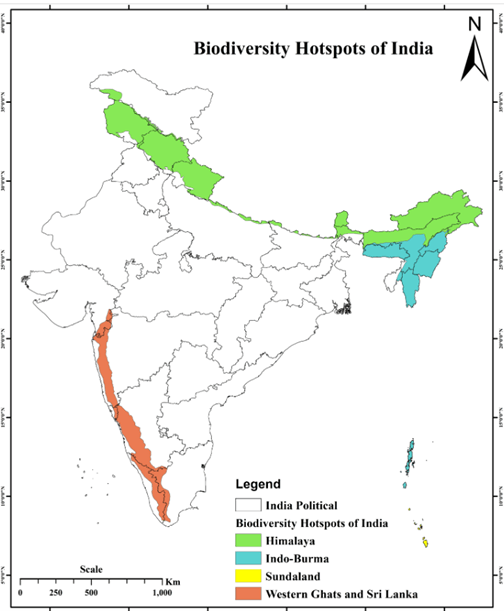
About Arittapatti:
- Arittapatti BHS is 139.63 hectares in Arittapatti village (Melur block) and 53.8 hectares in Meenakshipuram village (Madurai East taluk).
- Arittapatti village, known for its ecological and historical significance, houses around 250 species of birds including three important raptors – birds of prey, namely the Laggar Falcon, the Shaheen Falcon and Bonelli’s Eagle.
- It is also home to wildlife such as the Indian Pangolin, Slender Loris and pythons
- The area is surrounded by a chain of seven hillocks or inselbergs that serve as a watershed, charging “72 lakes, 200 natural springs and three check dams
- The Anaikondan tank, built during the reign of Pandiyan kings in the 16th century is one among them.
- Several megalithic structures, rock-cut temples, Tamil Brahmi inscriptions and Jain beds add to the historical significance of the region.
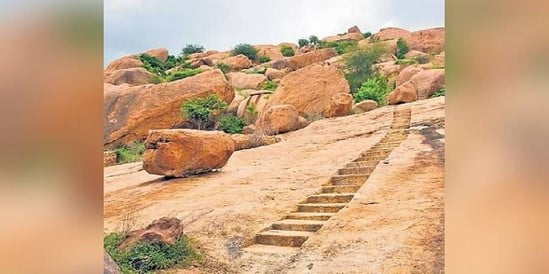
Source: The Hindu
Previous Year Question
Q1.) The most important strategy for the conservation of biodiversity together with traditional human life is the establishment of (2014)
- biosphere reserves
- botanical gardens
- national parks
- wildlife sanctuaries
Syllabus
- Prelims – Current Affairs
In News: the Supreme Court observed while hearing the Jallikattu case that, prevention of cruelty is not an “absolute idea”. The Constitution commands us to be compassionate to all living creatures, but it should have a balance.
- The Bench also referred to the killing of stray dogs, saying it extinguished the life of an animal.
About Jallikattu:
- It is an ancient ‘sport’ or bull taming event typically practiced in Tamil Nadu as a part of Pongal celebrations on Mattu Pongal day, third day of the four-day Pongal festival.
- Jalli refers to gold or silver coins and Kattu means ‘tied’.
- Therefore, combined it refers to coins being tied to the bulls’ horns, which is considered the prize for whoever tames the bull.
- The bull that wins is used to service numerous cows preserving the native breed.
- It is believed to have been practised some 2500 years ago.
- It is controversial because the sport often results in major injuries and even deaths.

About the case:
- In 2018, the apex court had referred to a Constitution Bench the question whether the people of Tamil Nadu could preserve jallikattu as their cultural heritage under Article 29 (1) of the Constitution and demand for its protection.
- The People for Ethical Treatment of Animals (PETA) filed a petition to strike down the Prevention of Cruelty to Animals (Tamil Nadu Amendment) Act of 2017 and Prevention of Cruelty to Animals (Conduct of Jallikattu) Rules of 2017.
- In 2021, the Environment Ministry declared that the sport could carry on irrespective of the imposed ban.
- A research conducted by PETA’s investigators found that the bulls were being disoriented, deliberately. The bulls’ tails were allegedly bitten and twisted; stabbed, punched, and dragged on the ground.
Source The Hindu
Previous Year Question
Q.1) With reference to India’s culture and tradition, what is `Kalaripayattu’? (2014)
- It is an ancient Bhakti cult of Shaivism still prevalent in some parts of South India
- It is an ancient style bronze and brasswork still found in southern part of Coromandel area
- It is an ancient form of dance-drama and a living tradition in the northern part of Malabar
- It is an ancient martial art and a living tradition in some parts of South India
Syllabus
- Mains – GS 2 (Governance)
Context: The Global Hunger Index (GHI) 2022 has brought more unwelcome news for India, as far as its global ranking on a vital indicator of human development is concerned. India ranked 107 out of 121 countries.
- The Government of India attempted to discredit the index immediately in its attempt to deny the findings of the report, even going so far as to term it a conspiracy against India.
About Malnutrition:
- It refers to deficiencies, excesses or imbalances in a person’s intake of energy and/or nutrients.
- It is a chronic problem and a longstanding challenge for the public administration of India.
- The term malnutrition addresses 3 broad groups of conditions:
- Undernutrition:
- It includes wasting (low weight-for-height), stunting (low height-for-age) and underweight (low weight-for-age)
- Together, the stunted and wasted children are considered to be underweight, indicating a lack of proper nutritional intake and inadequate care post-childbirth.
- Micronutrient-related malnutrition:
- It includes micronutrient deficiencies (a lack of important vitamins and minerals) or micronutrient excess; and
- Overweight:
- It includes obesity and diet-related noncommunicable diseases (such as heart disease, stroke, diabetes and some cancers).
About Global Hunger Index:
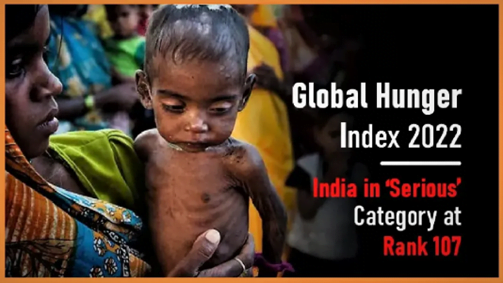
- The GHI is an important indicator of nutrition, particularly among children, as it looks at 4 factors:
- Child stunting
- Child wasting
- Child mortality
- Undernutrition (calorific deficiency) across the population.
- GHI is a tool for comprehensively measuring and tracking hunger at global, regional, and national levels.
- It is an annual by European NGOs of Concern Worldwide and Welthungerhilfe.
India’s performance in GHI 2022:
- India has a score of 29.1 which places it under ‘serious’ category.
- Among the South Asian countries, India (107) is ranked below Sri Lanka (64), Nepal (81), Bangladesh (84), and Pakistan (99). Afghanistan (109) is the only country in South Asia that performs worse than India on the index.
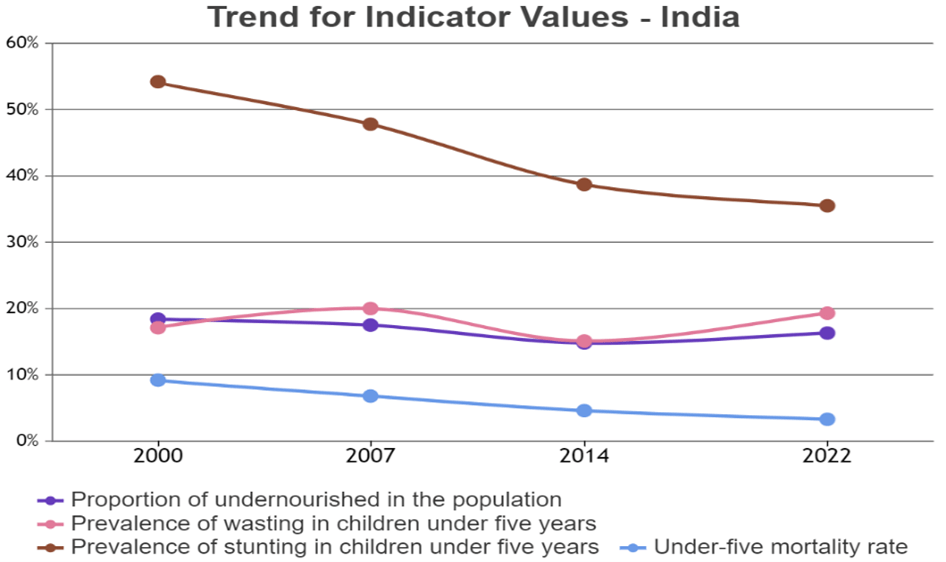
Issues with addressing the problem of malnutrition:
Manpower constraints:
- Over 50% Child Development Project Officer (CDPO) posts were vacant in Jharkhand, Assam, Uttar Pradesh, and Rajasthan, pointing to severe manpower constraints in successfully implementing the scheme of such importance.
No routine in social audits:
- Social audits that are meant to allow for community oversight of the quality of services provided in schools are not carried out routinely.
Inadequate funding & implementation:
- Gaps remain in how the already existing centrally-sponsored schemes are funded and implemented.
- The budgets being allocated are nowhere near the scale of the funds that are required to improve nutrition in the country.
- For example, the Saksham Anganwadi and Prime Minister’s Overarching Scheme for Holistic Nutrition (POSHAN) 2.0 scheme (which now includes the Integrated Child Development Services (ICDS) scheme), which seeks to work with adolescent girls, pregnant women, nursing mothers and children below three.
- However, the budget for this scheme for FY2022-23 was less than 1% more than the actual spend in FY2020-21.
Issues with cash transfers:
- Cash transfers seem to be a favoured solution for several social sector interventions in India today, and this includes the health and nutrition sectors.
- But evidence of the impact of cash transfer on child nutrition in India is limited so far.
- The effect of cash transfers is also limited in a context where food prices are volatile and inflation depletes the value of cash.
Social Factors:
- Equally, there are social factors such as ‘son preference’, which sadly continues to be prevalent in India and can influence household-level decisions when responding to the nutrition needs of sons and daughters.
Other factors:
- Malnutrition persists due to depressed economic conditions in large parts of the country, the poor state of agriculture in India, persistent levels of unsafe sanitation practices, etc.
Measures Taken to Tackle Malnutrition:
- Poshan Abhiyan:
- It is a multi-ministerial convergence mission with the vision to ensure the attainment of malnutrition free India by 2022.
- The Ministry of Women and Child Development (MWCD) is implementing POSHAN Abhiyaan.
- Prime Minister’s Overarching Scheme for Holistic Nutrition (POSHAN) 2.0 scheme:
- It now includes the Integrated Child Development Services (ICDS) scheme, which seeks to work with adolescent girls, pregnant women, nursing mothers and children below three.
- Integrated Child Development Services:
- It represents one of the world’s largest and unique programmes for early childhood care and development.
- The beneficiaries under the Scheme are children in the age group of 0-6 years, pregnant women and lactating mothers.
- The Ministry of Women and Child Development is the implementing agency.
- Mid-Day Meal Scheme:
- The Mid-day Meal Scheme is a school meal programme in India designed to better the nutritional standing of school-age children
- It covers all school students studying in Classes 1 to 8 of government schools, government-aided schools, special training centres, including madrasas supported under Samagra Shiksha Abhiyan.
- National Food Security Mission:
- It was launched in 2007-08 by the Ministry of Agriculture and Farmers’ Welfare as a Centrally Sponsored Scheme.
- It focuses on the sustainable increase in the production of targeted crops through area expansion and productivity enhancement.
- National Nutrition Mission:
- It is the government’s flagship programme to improve nutritional outcomes for children, pregnant women and lactating mothers.
- To reduce stunting and wasting by 2 percent per year (total 6 per cent until 2022) among children and anaemia by 3 percent per year (total 9 per cent until 2022) among children, adolescent girls and pregnant women and lactating mothers.
- The Ministry of Women and Child Development is the nodal ministry for implementation.
Suggestions Measures to Improve Malnutrition in India:
- Need of a comprehensive programme:
- A comprehensive programme targeting adolescent girls is required if the intergenerational nature of malnutrition is to be tackled.
- Cash transfers:
- Cash transfers can also be used to incentivise behavioural change in terms of seeking greater institutional support.
- Food rations through PDS and special supplements for the target group of pregnant and lactating mothers, and infants and young children, are essential.
- Fixing the pre-existing schemes:
- Fixing the pre-existing schemes is the obvious answer to addressing India’s multi-dimensional nutrition challenge.
- Getting the already existing schemes right requires greater involvement of local government and local community groups in the design and delivery of tailored nutrition interventions.
- Keeping it a top priority:
- The need of the hour is to make addressing child malnutrition the top priority of the government machinery, and all year around.
Source: The Hindu
Syllabus
- Mains – GS 2 (Governance)
Context: Since tenant farmers do not have land ownership documents, the Central Government has excluded them from receiving PM Kisan. However, the Odisha government has included tenant farmers under the KALIA scheme.
About KALIA Scheme:
KALIA stands for “Krushak Assistance for Livelihood and Income Augmentation”. It was launched by the Odisha government in January 2018.
- Eligibility:
- Small and marginal farmers, landless Agricultural households, vulnerable Agricultural households, landless Agricultural laborers, and sharecroppers (Actual cultivators) all growth is eligible under different components of the scheme.
- Benefits:
- Financial assistance of Rs.25,000/- per farm family over five seasons will be provided to small and marginal farmers so that farmers can purchase inputs like seeds, fertilizers, and pesticides and use assistance towards labour and other investments.
- Financial Assistance of Rs.12500/-will be provided to each landless Agricultural Household for Agricultural allied activities like small goat rearing units, mini-layer units, duckery units, fishery kits for fishermen, mushroom cultivation and bee-keeping, etc.
- This will particularly benefit to SC & ST population of our State.
- The vulnerable cultivators/landless agricultural laborers will get financial assistance of Rs. 10,000/- per family per year to enable them to take care of their sustenance.
- The vulnerable cultivator/landless Agricultural Laborers who are in old age, have a disability/disease, and are vulnerable for any other reason.
About the Odisha model:
- The Direct Benefits Transfer (DBT) scheme facilitates the transfer of subsidies to beneficiaries’ bank accounts, but identifying the appropriate beneficiaries is complex.
- The Odisha Government’s move stands out and should prompt every other State to adopt it.
- The Odisha Government restricts land leasing; however, it includes tenant farmers as one of the beneficiaries to receive KALIA under the three-stage process of the unification-verification-exclusion framework.
Unification:
- Unification begins with unifying State databases with green forms.
Verification:
- Verification is done through multiple databases like the Agricultural Census, Socio-Economic Caste Census, National Food Security Act, National Population Registry, HRMS database of State government employees, bank account validation through bank databases, and de-duplication through Aadhaar.
Exclusion:
- The last phase excludes ineligible recipients, such as government employees, taxpayers, large farmers, and anybody who voluntarily opted out.
- Algorithms for data integration were created by employing the concept of unification, verification, and exclusion.
- This is a technology-led transformation to receive direct income support for tenant farmers even without having land documents.
- So, hereafter, no State can say that tenant farmers are not eligible to receive such payments.
Restricted Agricultural Land Leasing Rights:
- Kerala is the only State to completely prohibit leasing. Most of the other States have some exceptions.
- For instance, Karnataka enables soldiers and seamen to lease their property, whereas Madhya Pradesh allows leasing to handicapped individuals and widows. And in Gujarat, the leasing regulations differ by area.
- Some States allow leasing with few terms and conditions.
- In Bihar, Chhattisgarh, Gujarat, Himachal Pradesh, Andhra Pradesh, Tamil Nadu, and Telangana, the landlord does not get all of the lands back.
- The landowners, therefore, have no clue what they will get when they lease out their property.
- This puts the profitability of leasing fully contingent on external circumstances. This has caused the official land leasing market to be severely depressed.
What do the surveys indicate?
- Based on household surveys, the Sample Survey Office estimates that 13 percent of land in India is leased.
- However, according to the Agri Census statistics based on land records, just 0.36 percent of the land is shown as officially leased.
Plight of tenant farmers:
- 36 percent of India’s tenant farmers were completely landless and 56 percent owned less than one hectare.
- Across the country, over 20 percent of land holdings are farmed by tenant farmers who cannot access facilities like credit and other support services.
Impending investment:
- Restrictive land leasing legislation has ultimately resulted in impeding investments in the agriculture sector and, thus, impacted Agri-productivity.
Adoption of model land leasing act:
- To mitigate this disparity, States have to come forward to adopt the Model (Agricultural) Land Leasing Act proposed by NITI Aayog in 2016.
- This Act would allow for the profitable use of fallow land and provide tenant farmers with access to credit and insurance services.
Way Forward:
- With the PM-Kisan comprising the largest component in the agriculture budget, there is a need to address its deficiencies drawing from the experiences of Odisha’s KALIA scheme and Telangana’s Rythu Bandhu Scheme.
- A land reforms agenda, particularly the land leasing legislations and updated land records, should receive the highest priority to increase the incomes of smallholders, tenant farmers, and sharecroppers.
- So, the time is right for States to amend the existing laws related to land leasing for securing the rights of tenant farmers.
Source: The Hindu
Syllabus
- Mains – GS 2 Governance
Context:
- India’s transparency regime is in trouble as the very institution mandated to guard it (Central Information Commission or CIC) has become responsible for its downfall.
- It had passed orders seeking transparency in many cases of public importance.
- However, the present set of Information Commissioners have together adopted a new jurisprudence that has created additional hurdles in a citizen’s quest for accountability.
Central Information Commission:
- Established under the Right to Information (RTI) Act 2005, it is the apex body under India’s transparency regime.
- Its most vital mandate is to decide the disclosure or the non-disclosure of information.
- Citizens can file applications under the Right to Information Act with any public body and are guaranteed a reply from the public information officer of that public body within 30 days.
- Under the RTI Act, when an applicant is denied information by a government department, the first appeal is made to the appellate authority in the department. If unresolved, the RTI applicant can move the office of the Central Information Commission (CIC)—for queries related to central government—or State Information Commission.
- Information Commissioners (ICs) appointed to the CIC are equal in status to the Chief Election Commissioner, and that of a Supreme Court judge; having a a five-year fixed term and terms of service.
- In its current form, Section 8 of the RTI Act lists ten exemptions, ranging from any information that may hurt national security, impede the process of ongoing investigations to cabinet papers and deliberations of the council of ministers.
Challenges to RTI:
- Centre’s dominance: After the amendments of 2019, the Centre gave itself powers to change and decide these terms whenever it wished, thereby striking at the independence of the commission and those who man it.
- Lack of public welfare orientation: The CIC has become more like a walking dead institution, where records will show that not a single order for disclosure has been forthcoming in matters of public importance.
- Delay in hearings: Cases at the CIC come up for a hearing roughly after a two year wait. If the matter is not already infructuous or lost its significance, one can look forward to the commission deciding one’s case.
- In a case seeking disclosure of documents relating to the making of the Unlawful Activities (Prevention) Amendment Act, 2019, the commission has resorted to keeping the matter pending for final order for more than three months now, something which is unheard of.
- Lack of transparency: In matters of public importance, such as cases seeking disclosure of files related to the national lockdown during COVID-19, or the case seeking disclosure of data pertaining to phone tapping orders passed by the Home Ministry, the Commission has adopted a new way of delegating its mandate — to decide cases — to the Ministry before it.
- Vagueness: In most cases, the Ministries reiterate their stand of non-disclosure, most often under vague grounds of national interest.
- Lack of procedure: The CIC refuses to accept any further challenge to such orders, therefore, refusing to do its duty of deciding the cases.
- One of the cardinal rules of natural justice is that no one should be a judge in their own cause.
- However, the commission now allows, or rather wants, the very Ministry that stands accused of violating the RTI Act to act as the judge in their own cause and decide whether a disclosure is necessary.
- Such as, CIC refused to hear the Internet Freedom Foundation’s challenge to the fresh non-disclosure order passed by the Home Ministry in the phone tapping case.
- Ultra-virus actions: In another case related to disclosure of non-performing assets and top defaulters of a co-operative bank, the matter was listed out-of-turn to issue a “stay” order against the Bank’s First Appellate Authority’s order for disclosure. A stay order is unheard of and there is no provision in the RTI Act for the same.
- High number of vacancies: information commissions are purposely deprived of commissioners to scuttle the effective functioning of the RTI Act.
Suggestions for future:
- Simplicity: Unlike court cases, RTI matters do not involve complex legal arguments and are simple to adjudicate.
- Reduce pendency: In May 2014, close to 35,000 appeals were pending before the CIC.
- In June 2019, about 31,000 appeals were pending, over 9,000 of those pending for over a year.
- Fill vacancy: Currently, four out of the ten positions of information commissioners are vacant.
- Several information commissions in the states were either non-functional or working at a reduced capacity.
- Prune the exemption list: In an RTI ratings report by the Canada-based Centre for Law and Democracy, India’s rank slipped from second position in 2011 to eighth in 2018.
- It flagged blanket exemptions from the RTI to “security, intelligence, research and economic institutes” and “information held by private entities which perform a public function”.
- Protect whistle-blowers: In March 2018, Nanji Sondarva was allegedly clubbed to death in Gujarat’s Rajkot district after filing an RTI application seeking details of a newly constructed road in his village.
- 84 RTI activists have been murdered since 2005 for seeking information on illegal construction, alleged scams in social welfare scheme.
- CIC as a constitutional body: the RTI is safeguarding a fundamental right guaranteed under the Constitution.
- Article 19 (1)(a) of the Constitution guarantees freedom of speech and expression to citizens, but without the RTI, one cannot express oneself, including while making an electoral choice.
- the Supreme Court has also interpreted RTI as a fundamental right—in 1975 and 1982.
- Political parties under RTI: Political parties are reluctant to share information with citizens.
- The CIC classified political parties as a public authority since they benefit from land allotted by the government at cheap rates, free air time with state broadcasters during elections, and are allowed to claim income tax exemptions.
Way forward:
- Citizens must mount intense pressure on authorities to act and appoint commissioners of integrity.
- Lawyers must help willing citizens take matters to court and seek justice.
- If there is a failure to do so, India will lose its cherished right to know.
Source: LiveMint
Baba’s Explainer – New Data Protection Bill
Syllabus
- GS-2: Government policies and interventions for development in various sectors and issues arising out of their design and implementation.
- GS-3: Digital Economy
Context: The latest draft of the data protection law — the Digital Personal Data Protection Bill, 2022 (DPDP Bill, 2022) — has now been made open for public comments and the government is expected to introduce the Bill in Parliament in the budget session of 2023.
Read Complete Details on New Data Protection Bill
Practice MCQs
Q.1) With reference to Biodiversity Heritage sites, consider the following statements:
- They are unique, ecologically fragile ecosystems that need protection.
- As per Biodiversity Act 2000, Central Governments may notify such sites.
Which of the statements given above is/are correct?
- 1 only
- 2 only
- Both 1 and 2
- Neither 1 nor 2
Q.2) ‘Champions of the Earth’ is an award launched by
- The World Meteorological Organisation
- The Intergovernmental Panel on Climate Change
- The UNEP
- The UNFCCC Secretariat
Q.3) Consider the following statements regarding the Nyingma Sect of Buddhism:
- Nyingmapa’s trace their translation lineage back to the Samye Monastery, the first Tibetan Buddhist monastery in Tibet.
- The Nyingma sect is also known as the orange Hat sect because its Lamas wear red robes and hats.
Which of the following statements given above is/are correct?
- 1 only
- 2 only
- Both 1 and 2
- Neither 1 nor 2
Comment the answers to the above questions in the comment section below!!
ANSWERS FOR ’25th November 2022 – Daily Practice MCQs’ will be updated along with tomorrow’s Daily Current Affairs.st
ANSWERS FOR 24th November – Daily Practice MCQs
Q.1) – b
Q.2) – c
Q.3) – b













